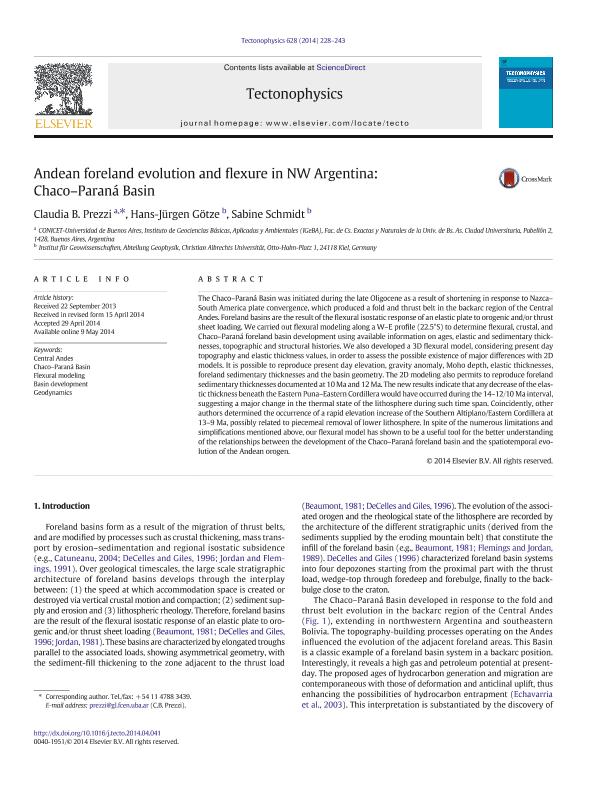Mostrar el registro sencillo del ítem
dc.contributor.author
Prezzi, Claudia Beatriz

dc.contributor.author
Götze, Hans Jürgen
dc.contributor.author
Schmidt, Sabine
dc.date.available
2017-06-21T17:52:45Z
dc.date.issued
2014-07
dc.identifier.citation
Prezzi, Claudia Beatriz; Götze, Hans Jürgen; Schmidt, Sabine; Andean Foreland Evolution and Flexure in NW Argentina: Chaco-Paraná Basin; Elsevier Science; Tectonophysics; 628; 7-2014; 228-243
dc.identifier.issn
0040-1951
dc.identifier.uri
http://hdl.handle.net/11336/18542
dc.description.abstract
The Chaco–Paraná Basin was initiated during the late Oligocene as a result of shortening in response to Nazca–South America plate convergence, which produced a fold and thrust belt in the backarc region of the Central Andes. Foreland basins are the result of the flexural isostatic response of an elastic plate to orogenic and/or thrust sheet loading. We carried out flexural modeling along a W–E profile (22.5°S) to determine flexural, crustal, and Chaco–Paraná foreland basin development using available information on ages, elastic and sedimentary thicknesses, topographic and structural histories. We also developed a 3D flexural model, considering present day topography and elastic thickness values, in order to assess the possible existence of major differences with 2D models. It is possible to reproduce present day elevation, gravity anomaly, Moho depth, elastic thicknesses, foreland sedimentary thicknesses and the basin geometry. The 2D modeling also permits to reproduce foreland sedimentary thicknesses documented at 10 Ma and 12 Ma. The new results indicate that any decrease of the elastic thickness beneath the Eastern Puna–Eastern Cordillera would have occurred during the 14–12/10 Ma interval, suggesting a major change in the thermal state of the lithosphere during such time span. Coincidently, other authors determined the occurrence of a rapid elevation increase of the Southern Altiplano/Eastern Cordillera at 13–9 Ma, possibly related to piecemeal removal of lower lithosphere. In spite of the numerous limitations and simplifications mentioned above, our flexural model has shown to be a useful tool for the better understanding of the relationships between the development of the Chaco–Paraná foreland basin and the spatiotemporal evolution of the Andean orogen.
dc.format
application/pdf
dc.language.iso
eng
dc.publisher
Elsevier Science

dc.rights
info:eu-repo/semantics/openAccess
dc.rights.uri
https://creativecommons.org/licenses/by-nc-sa/2.5/ar/
dc.subject
Chaco-Paraná Basin
dc.subject
Flexural Modelling
dc.subject
Basin Development
dc.subject.classification
Geoquímica y Geofísica

dc.subject.classification
Ciencias de la Tierra y relacionadas con el Medio Ambiente

dc.subject.classification
CIENCIAS NATURALES Y EXACTAS

dc.title
Andean Foreland Evolution and Flexure in NW Argentina: Chaco-Paraná Basin
dc.type
info:eu-repo/semantics/article
dc.type
info:ar-repo/semantics/artículo
dc.type
info:eu-repo/semantics/publishedVersion
dc.date.updated
2017-06-21T15:33:45Z
dc.journal.volume
628
dc.journal.pagination
228-243
dc.journal.pais
Países Bajos

dc.journal.ciudad
Amsterdam
dc.description.fil
Fil: Prezzi, Claudia Beatriz. Consejo Nacional de Investigaciones Científicas y Técnicas. Oficina de Coordinación Administrativa Ciudad Universitaria. Instituto de Geociencias Basicas, Aplicadas y Ambientales de Buenos Aires. Universidad de Buenos Aires. Facultad de Ciencias Exactas y Naturales. Instituto de Geociencias Basicas, Aplicadas y Ambientales de Buenos Aires; Argentina
dc.description.fil
Fil: Götze, Hans Jürgen. Christian Albrechts Universität; Alemania
dc.description.fil
Fil: Schmidt, Sabine. Christian Albrechts Universität; Alemania
dc.journal.title
Tectonophysics

dc.relation.alternativeid
info:eu-repo/semantics/altIdentifier/doi/https://doi.org/10.1016/j.tecto.2014.04.041
dc.relation.alternativeid
info:eu-repo/semantics/altIdentifier/url/http://www.sciencedirect.com/science/article/pii/S0040195114002315
Archivos asociados
